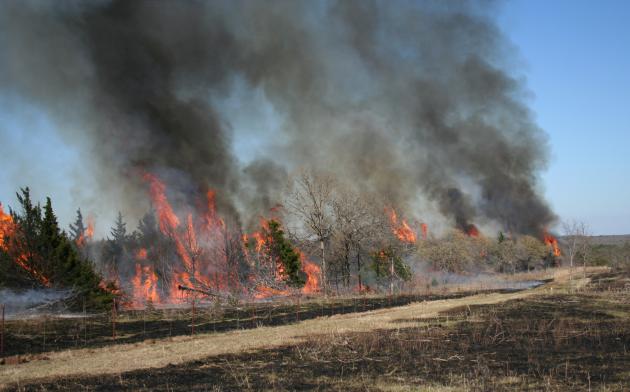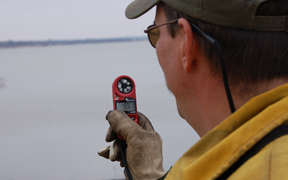A fire prescription is a set of conditions under which a fire will be set to meet land management objectives. It is based on scientific research and experience.
First, determine the management goals and objectives of the area to be burned. Next, develop a fire prescription for that area. Prescriptions may require specialized personnel, tactics, training, equipment, and firebreaks. Consultation with a fire management specialist will help in developing custom fire prescriptions that will meet the objectives of the unit.
General Guidelines
Rule 1. For those in the process of learning to burn or with limited experience, use the 60:40 Rule. The 60:40 rule states that you burn with an air temperature of less than 60°F, a relative humidity greater than 40%, and a wind speed of 5-15 mph measured at 6 feet above the surface of the ground.
Rule 2. For those concerned about weather conditions changing out of the prescription, use the Rule of Halves. This rule is used in the field to predict changes in fire behavior. When the air temperature increases by 20°F, the relative humidity decreases by 50%. For example, if the air temperature changes from 60°F with 40% relative humidity to 80°F, the relative humidity will change from 40% to 20%. A fire that can be conducted safely at 40% relative humidity may pose a safety risk at 20%.
Rule 3. In most cases, do not burn if there is a forecasted frontal passage or wind shift within 12 hours.
Rule 4. In general, the width of firebreak on the down wind side of the area to be burned should be 10 times the height of flammable vegetation. Firebreaks are usually a combination of bare ground, mowed strips, and backfired strips. In woodlands, leaf blowers are often used to create a bareground fire break. Landscape features such as streams and roads also can make adequete firebreaks. If the firebreak is insufficient, you may experience a fire escape.
Rule 5. If the conditions are not right, including all parts of the prescription (adequate personnel, equipment, weather conditions, etc.), do not start the fire. Wait until everything is right.
Rule 6. If the fire is not going well, put it out.
Rule 7. Do not leave the fire until it is completely out, that is no visable smoke for at least one hour.
Special Considerations
Trees and brush should never be cut, dozed and piled prior to a prescribed burn. This will complicate the burn and increase spotfire chances. Research has shown that brush piles can cause spotfires up to 500 feet down wind. If piling is necessary, push piles 300 feet into the burn unit, keep piles small and keep an eye down wind of them during the prescribed burn.

Burning brush piles in the summer when surrounding plants are green.
The best time to burn brush piles is after the prescribed fire has been conducted. Burn when the area is black or let the burn unit green up. Safe times to burn brush piles include early summer months when surrounding grass is green and and well hydrated (May and June for much of the Great Plains). Burning in the winter with dormant fuels and dry conditions can cause problems, even when burning brush piles with snow on the ground. Large brushpiles can burn for days, sometimes weeks, and when the snow melts the spotfire risk increases.
Safety Concerns
Burns with high temperatures and low humidity are for experienced fire bosses and crews. Look back at the general guidelines for prescribed fires.
Research has shown that if a prescribed fire is conducted with relative humidity under 25% there is a 100% probability of a spotfire occurring. There is only a 46% chance of a spotfire when the humidity is between 25% and 29%. Spotfires significantly decrease when prescribed fires are conducted when the relative humidity is higher than 40%. This does not suggest that prescribed fires cannot be conducted under 40% humidity, but is one of the many decisions that needs to be made when planning a prescribed burn.
Smoke Management

Burning under good smoke dispersion conditions.
Burning on days that have good smoke dispersion can reduce smoke effects. Before beginning a prescribed fire, the effects of smoke downwind must be considered. Burning so that smoke disperses away from sensitive areas (residential areas, hospitals, highways, and airports) must be considered in the burn plan. If smoke is a concern, consider burning dry fuels over moist fuels. Backfires also tend to produce less smoke than flank or headfires.
For more detailed information about prescribed fire prescriptions, view this fact sheet: http://pods.dasnr.okstate.edu/docushare/dsweb/Get/Document-2704/NREM-2878web.pdf

